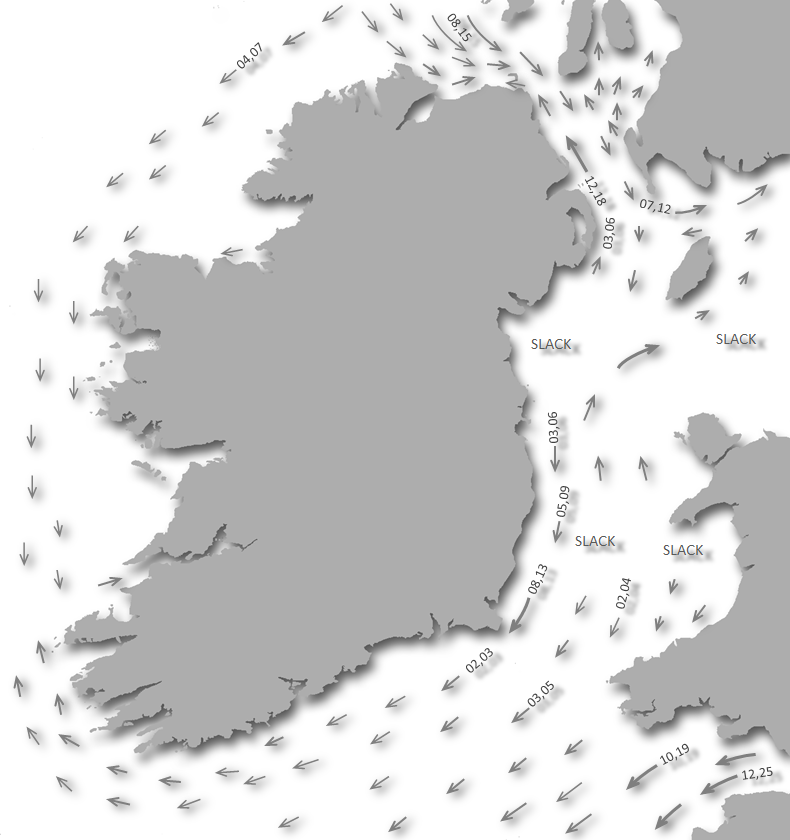
Kinnagoe Bay is situated on the north coast of Ireland on the Inishowen Peninsula, about fifteen miles southeast of Malin Head and four miles to the northwest of Inishowen Head. The bay offers an anchorage off an expansive beach in beautiful secluded surroundings.
Kinnagoe Bay makes for a tolerable anchorage that affords good shelter and protection from winds from southwest through south to southeast. Daylight access is straightforward as there are no dangers inside the bay and it may be addressed at all stages of the tide.

Keyfacts for Kinnagoe Bay
Last modified
July 10th 2021 Summary
A tolerable location with straightforward access.Facilities


Nature






Considerations

Position and approaches
Expand to new tab or fullscreen
Haven position
 55° 15.560' N, 007° 0.450' W
55° 15.560' N, 007° 0.450' WThis is a possible anchoring location off the beach.
What is the initial fix?
The following Kinnagoe Bay Initial Fix will set up a final approach:
 55° 15.885' N, 006° 59.300' W
55° 15.885' N, 006° 59.300' W What are the key points of the approach?
Offshore details are available in the northeast Ireland’s Coastal Overview for Malin Head to Strangford Lough  .
.
 .
.- A berth of 300 metres from the shore clears all dangers.
- The Lough Foyle approaches, detailed in the Foyle Port Marina (Derry City)
entry, provides general approaches to the area.
- Approach the centre of Kinnagoe Bay, between its rocky headlands, and anchor in sand.
Not what you need?
Click the 'Next' and 'Previous' buttons to progress through neighbouring havens in a coastal 'clockwise' or 'anti-clockwise' sequence. Below are the ten nearest havens to Kinnagoe Bay for your convenience.
Ten nearest havens by straight line charted distance and bearing:
- Tremone Bay - 2.3 nautical miles WNW
- Portkill - 2.9 nautical miles ESE
- Portnocker - 3.3 nautical miles ESE
- White Bay - 3.4 nautical miles SE
- Cornashamma Bay - 3.4 nautical miles SE
- Silver Strand - 3.5 nautical miles SSE
- Greencastle - 3.6 nautical miles SSE
- Magilligan Point - 4.3 nautical miles SSE
- Moville - 4.6 nautical miles SSW
- Carrickarory Pier - 5 nautical miles SSW
These havens are ordered by straight line charted distance and bearing, and can be reordered by compass direction or coastal sequence:
- Tremone Bay - 2.3 miles WNW
- Portkill - 2.9 miles ESE
- Portnocker - 3.3 miles ESE
- White Bay - 3.4 miles SE
- Cornashamma Bay - 3.4 miles SE
- Silver Strand - 3.5 miles SSE
- Greencastle - 3.6 miles SSE
- Magilligan Point - 4.3 miles SSE
- Moville - 4.6 miles SSW
- Carrickarory Pier - 5 miles SSW
What's the story here?

Kinnagoe Bay is a large bay situated between Kinnagoe Head and Balbane Head on the northeast corner of the Inishowen Peninsula. Set two miles northwest of Inishowen Head and the entrance channel to Lough Foyle, approaches to the area are detailed in the Foyle Port Marina (Derry City)
 entry.
entry.How to get in?
 The Kinnagoe Bay initial fix is ¾ of a mile out, situated on the 20-metre contour approximately halfway between Dungloon Rocks and The Dutchman reef that extends 250 metres seaward from the southeast side of the bay. A bearing of 245° T for a distance of ¾ of a mile from the initial fix will lead into one of the possible anchoring locations in the area. The bay is free of obstructions.
The Kinnagoe Bay initial fix is ¾ of a mile out, situated on the 20-metre contour approximately halfway between Dungloon Rocks and The Dutchman reef that extends 250 metres seaward from the southeast side of the bay. A bearing of 245° T for a distance of ¾ of a mile from the initial fix will lead into one of the possible anchoring locations in the area. The bay is free of obstructions.  Anchor within according to draft in a position that makes the best of the prevailing conditions. Holding is very good in sand but there are occasional rocks. Land on the beach by dingy.
Anchor within according to draft in a position that makes the best of the prevailing conditions. Holding is very good in sand but there are occasional rocks. Land on the beach by dingy.Why visit here?
Kinnagoe Bay derives its name from the Irish Bá Chionn an Ghabha with ceann, or cionn, meaning ‘head or headland’ of gabha ‘smith’. The bay is regarded by many as being the most beautiful along this coastline. Here the high Inishowen coastal cliffs drop down to the sea enclosing a crescent of spectacular golden sands. The secluded bay is truly a hidden County Donegal gem and is listed on the Inishowen 100 scenic route.
Kinnagoe Bay’s fame, however, is derived more from history than its natural beauty. For it was here that ‘La Trinidad Valencera’, one of the ill-fated Spanish Armada galleons, foundered in a terrible storm whilst fleeing the English fleet. The year was in 1588 when more than two dozen fleeing ships of the Spanish Armada came too close to Irish shores. They foundered upon coastal rocks from Antrim to Kerry. Close by and caught in the eye of a hurricane, one of the most ferocious ever to hit the area, the ‘Barca de Amburg’ started taking in water and was abandoned. It capsized off the north Antrim coast and her crew were taken on board other ships that in turn sank. In the same vicinity the ‘Castillo Negro’ disappeared without trace taking all 310 souls aboard with her. On the 16th September the badly damaged 42 gun ‘ La Trinidad Valencera’ elected to run aground on the sands of Kinnagoe Bay in an effort to save its crew. So ended the fate of the fourth largest ship of the Spanish Armada.
It was not until February 1971 that the last resting place of ‘La Trinidad Valencera’ was finally discovered. During a dive by members of the City of Derry Sub-Aqua Club, artefacts were discovered that later confirmed the wreck. These included bronze cannons bearing the arms of the King Philippus Rex; weapons from skilled Venetian craftsmen; pieces of stringed instruments; wheels and navigational tools; grenades and pottery. Some of the impressive finds from the ship, including recovered cannons, are housed in the Tower Museum in Derry.

Above the bay today a plaque commemorates the wreck with one of the finest views in Ireland as the backdrop. The wreck is now favoured by many fish, which can be caught by either spinning from the rocks or casting from the beach. They include pollack, wrasse, coalfish, dogfish, bass, and flounder that attract fisherman from all around Ireland. A weaving road from the top of the hill leads down to the beach where there is a small car park which gets very busy during the summer.
From a sailing perspective Kinnagoe Bay, along with the bays of Culdaff and Tremone, offer anchorages in beautiful locations on Inishowen’s northern shoreline just out of the main stream of the tide. These provide good passage anchorages for boats en route east or west or looking for a lunch stop.
What facilities are available?
Kinnagoe Bay is a secluded and remote bay with no facilities ashore save for an access road.Any security concerns?
Never an issue known to have occurred to a vessel anchored in Kinnagoe Bay.With thanks to:
Bill McCann, Londonderry Harbour Master. Photography with thanks to Oliver Dixon, Kay Atherton, Kenneth Allen, Bazonka and jp314159.



Aerial footage of the bay
About Kinnagoe Bay
Kinnagoe Bay derives its name from the Irish Bá Chionn an Ghabha with ceann, or cionn, meaning ‘head or headland’ of gabha ‘smith’. The bay is regarded by many as being the most beautiful along this coastline. Here the high Inishowen coastal cliffs drop down to the sea enclosing a crescent of spectacular golden sands. The secluded bay is truly a hidden County Donegal gem and is listed on the Inishowen 100 scenic route.

Kinnagoe Bay’s fame, however, is derived more from history than its natural beauty. For it was here that ‘La Trinidad Valencera’, one of the ill-fated Spanish Armada galleons, foundered in a terrible storm whilst fleeing the English fleet. The year was in 1588 when more than two dozen fleeing ships of the Spanish Armada came too close to Irish shores. They foundered upon coastal rocks from Antrim to Kerry. Close by and caught in the eye of a hurricane, one of the most ferocious ever to hit the area, the ‘Barca de Amburg’ started taking in water and was abandoned. It capsized off the north Antrim coast and her crew were taken on board other ships that in turn sank. In the same vicinity the ‘Castillo Negro’ disappeared without trace taking all 310 souls aboard with her. On the 16th September the badly damaged 42 gun ‘ La Trinidad Valencera’ elected to run aground on the sands of Kinnagoe Bay in an effort to save its crew. So ended the fate of the fourth largest ship of the Spanish Armada.
It was not until February 1971 that the last resting place of ‘La Trinidad Valencera’ was finally discovered. During a dive by members of the City of Derry Sub-Aqua Club, artefacts were discovered that later confirmed the wreck. These included bronze cannons bearing the arms of the King Philippus Rex; weapons from skilled Venetian craftsmen; pieces of stringed instruments; wheels and navigational tools; grenades and pottery. Some of the impressive finds from the ship, including recovered cannons, are housed in the Tower Museum in Derry.

Above the bay today a plaque commemorates the wreck with one of the finest views in Ireland as the backdrop. The wreck is now favoured by many fish, which can be caught by either spinning from the rocks or casting from the beach. They include pollack, wrasse, coalfish, dogfish, bass, and flounder that attract fisherman from all around Ireland. A weaving road from the top of the hill leads down to the beach where there is a small car park which gets very busy during the summer.
From a sailing perspective Kinnagoe Bay, along with the bays of Culdaff and Tremone, offer anchorages in beautiful locations on Inishowen’s northern shoreline just out of the main stream of the tide. These provide good passage anchorages for boats en route east or west or looking for a lunch stop.
Other options in this area
Click the 'Next' and 'Previous' buttons to progress through neighbouring havens in a coastal 'clockwise' or 'anti-clockwise' sequence. Alternatively here are the ten nearest havens available in picture view:
Coastal clockwise:
Portkill - 1.8 miles ESEPortnocker - 2 miles ESE
White Bay - 2.1 miles SE
Cornashamma Bay - 2.1 miles SE
Silver Strand - 2.2 miles SSE
Coastal anti-clockwise:
Tremone Bay - 1.4 miles WNWCuldaff Bay - 3.4 miles WNW
Portmore - 8 miles NW
Portachurry - 8 miles NW
Malin Harbour or Slievebane Bay - 8.1 miles WNW
Navigational pictures
These additional images feature in the 'How to get in' section of our detailed view for Kinnagoe Bay.



| Detail view | Off |
| Picture view | On |
Aerial footage of the bay
Add your review or comment:
Please log in to leave a review of this haven.
Please note eOceanic makes no guarantee of the validity of this information, we have not visited this haven and do not have first-hand experience to qualify the data. Although the contributors are vetted by peer review as practised authorities, they are in no way, whatsoever, responsible for the accuracy of their contributions. It is essential that you thoroughly check the accuracy and suitability for your vessel of any waypoints offered in any context plus the precision of your GPS. Any data provided on this page is entirely used at your own risk and you must read our legal page if you view data on this site. Free to use sea charts courtesy of Navionics.














